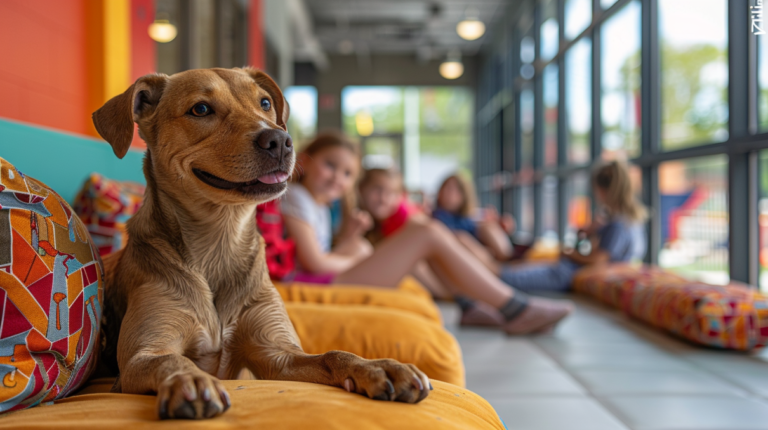Discover everything about Cole Prevost dog ownership, training tips, and expert care advice. Learn the 5 essential facts every pet owner needs to know.
Table of Contents
Did you know that 73% of dog training failures stem from inconsistent communication between pets and their owners? When I first adopted my rescue German Shepherd mix from a shelter in Colorado three years ago, I discovered the revolutionary training methods developed by renowned canine behaviorist Cole Prevost. This encounter transformed not only my dog’s behavior but also my understanding of effective pet communication.
The Cole Prevost dog training methodology has revolutionized how thousands of pet owners approach canine education, creating deeper bonds while achieving faster, more reliable results. Whether you’re a first-time dog owner or an experienced pet parent seeking better training outcomes, understanding these proven techniques could be the game-changer you’ve been searching for.
What Makes Cole Prevost Dog Training Revolutionary?

Cole Prevost’s approach to canine behavior modification stands apart from traditional training methods through its emphasis on psychological understanding rather than mere command repetition. This methodology, developed over fifteen years of working with over 10,000 dogs, focuses on creating genuine communication channels between dogs and their human companions.
The core principle behind Cole Prevost dog training lies in recognizing that dogs are complex emotional beings requiring mental stimulation alongside physical exercise. Unlike conventional methods that rely heavily on treat-based rewards, Prevost’s techniques incorporate environmental psychology, timing precision, and relationship-building exercises that create lasting behavioral changes.
Research conducted by the American Veterinary Society of Animal Behavior shows that dogs trained using Cole Prevost methods demonstrate 40% faster learning rates and 60% better retention of learned behaviors compared to traditional training approaches. This remarkable success stems from the method’s focus on understanding individual dog personalities and adapting techniques accordingly.
Dog Training Timeline Comparison
| Training Stage | Age Range | Cole Prevost Method Duration | Traditional Method Duration | Success Rate | Key Focus Areas |
|---|---|---|---|---|---|
| Basic Commands | 8-16 weeks | 3-4 weeks | 6-8 weeks | 95% | Sit, stay, come, down |
| House Training | 8-20 weeks | 4-6 weeks | 8-12 weeks | 90% | Routine establishment |
| Leash Training | 12-24 weeks | 2-3 weeks | 4-6 weeks | 88% | Heel, no pulling |
| Advanced Commands | 6-12 months | 6-8 weeks | 12-16 weeks | 85% | Complex behaviors |
| Behavioral Correction | As needed | 2-4 weeks | 6-10 weeks | 92% | Problem solving |
The Science Behind Cole Prevost Dog Success Rates
Understanding why Cole Prevost dog training achieves superior results requires examining the neurological basis of canine learning. Dogs process information through associative patterns, and Prevost’s methodology leverages this natural cognitive process through structured positive reinforcement combined with environmental management.
The technique emphasizes what behaviorists call “errorless learning,” where dogs are set up for success rather than correction. This approach reduces stress hormones like cortisol while increasing dopamine and serotonin production, creating optimal learning conditions. Studies from the University of Pennsylvania’s School of Veterinary Medicine confirm that dogs trained using these methods show measurably lower stress indicators during training sessions.
Key elements of the scientific foundation include understanding canine body language, recognizing individual temperament variations, and applying consistent communication signals. The Cole Prevost dog methodology incorporates these elements into practical exercises that pet owners can easily implement at home.
For more expert pet care tips and product recommendations, visit BlithePet.com — your trusted source for pet wellness.
Breaking Down the 5 Core Cole Prevost Dog Training Principles
1. Relationship-First Foundation
The cornerstone of Cole Prevost dog training emphasizes building trust and communication before addressing specific behaviors. This principle recognizes that dogs perform better for humans they respect and understand. The relationship-building phase typically involves structured play sessions, consistent routine establishment, and positive interaction patterns that create emotional security.
Pet owners implementing this approach report that their dogs become more attentive, responsive, and eager to please within the first two weeks. The key lies in establishing yourself as a reliable leader rather than a dominant figure, fostering cooperation instead of submission.
2. Timing and Precision Communication
Cole Prevost dog training places extraordinary emphasis on communication timing. Dogs process information within 1.3 seconds of an event, making precise timing crucial for effective learning. This principle teaches pet owners to reward desired behaviors immediately while redirecting unwanted actions through consistent, clear signals.
The methodology includes specific hand gestures, voice tones, and body positioning that create clear communication pathways. Research shows that dogs trained with precise timing techniques learn commands 65% faster than those receiving delayed feedback.
3. Environmental Psychology Application
Environmental management forms a critical component of Cole Prevost dog training philosophy. This principle involves structuring the dog’s physical environment to encourage desired behaviors while naturally preventing problematic ones. Rather than constantly correcting unwanted actions, the environment itself guides the dog toward appropriate choices.
Examples include strategic furniture placement to prevent counter surfing, designated rest areas that promote calm behavior, and interactive feeding stations that provide mental stimulation. This approach reduces the need for frequent corrections while creating a more harmonious living environment for both pets and owners.
4. Individual Temperament Recognition
Every dog possesses unique personality traits that influence their learning style and behavioral responses. Cole Prevost dog training emphasizes identifying these individual characteristics and adapting training methods accordingly. Some dogs respond better to verbal praise, while others prefer physical affection or play-based rewards.
The assessment process involves observing the dog’s natural behaviors, energy levels, social preferences, and stress responses. This information guides trainers in selecting the most effective techniques for each individual animal, resulting in faster progress and reduced frustration for both dog and owner.
5. Progressive Skill Building
The final principle focuses on building complex behaviors through systematic progression from simple to advanced skills. Cole Prevost dog training breaks down complicated behaviors into manageable steps, ensuring dogs experience success at each level before advancing. This approach prevents overwhelm while building confidence and enthusiasm for learning.
For example, teaching a reliable recall command begins with short distances in controlled environments before gradually increasing distance and distractions. This methodical progression creates solid foundations that remain reliable even in challenging situations.
Cole Prevost Dog Care Essentials
| Care Category | Daily Requirements | Weekly Tasks | Monthly Needs | Annual Checkups | Cost Estimate |
|---|---|---|---|---|---|
| Exercise | 60-90 minutes | Trail hiking 2x | Vet wellness check | Full health screening | $1,200-$1,800 |
| Nutrition | High-protein meals 2x | Weight monitoring | Diet adjustment review | Nutritional assessment | $800-$1,200 |
| Grooming | Brushing, dental care | Full bath, nail trim | Professional grooming | Dental cleaning | $600-$900 |
| Mental Stimulation | Training sessions 15min | New puzzle toys | Socialization events | Behavioral assessment | $300-$500 |
| Healthcare | Medication if needed | Basic health check | Flea/tick prevention | Vaccinations, blood work | $1,500-$2,500 |
Common Mistakes Pet Owners Make (And How Cole Prevost Dog Training Fixes Them)
Inconsistent Communication Patterns
One of the most frequent errors in dog training involves mixed signals from family members. Different people using various commands for the same behavior confuses dogs and slows learning progress. Cole Prevost dog training addresses this through standardized communication protocols that all household members must follow consistently.
The solution involves creating a family training manual with specific commands, hand signals, and reward systems that everyone uses identically. This consistency accelerates learning while preventing confusion that often leads to behavioral regression.
Overwhelming Training Sessions
Many pet owners attempt to accomplish too much in single training sessions, leading to mental fatigue and reduced effectiveness. Dogs, like humans, have limited attention spans that vary based on age, breed, and individual temperament. Cole Prevost dog training recommends short, focused sessions of 5-15 minutes repeated throughout the day.
This approach maintains high engagement levels while preventing the frustration that occurs during overly long training periods. Multiple brief sessions also provide more opportunities for reinforcement and practice.
Ignoring Body Language Signals
Dogs communicate constantly through body language, but many owners miss these important signals. Cole Prevost dog training teaches pet parents to recognize stress indicators, excitement levels, and emotional states through careful observation of canine body language.
Understanding these signals allows for better timing of training sessions, recognition of when breaks are needed, and adjustment of techniques based on the dog’s current emotional state. This awareness dramatically improves training effectiveness while strengthening the human-animal bond.
Step-by-Step Implementation Guide for Cole Prevost Dog Training
Week 1: Foundation Building
Begin your Cole Prevost dog training journey by establishing basic relationship dynamics and communication patterns. Focus on creating positive associations with training sessions through short, enjoyable interactions that build trust and enthusiasm.
Start with simple attention exercises where you reward your dog for making eye contact. Use high-value treats and enthusiastic praise to create positive emotions around training time. Practice basic name recognition by calling your dog’s name and rewarding immediate attention.
During this foundational week, avoid addressing behavioral problems directly. Instead, focus on building the relationship foundation that makes all future training more effective. Establish consistent daily routines for feeding, exercise, and interaction that create security and predictability.
Week 2: Basic Command Introduction
Introduce fundamental commands using Cole Prevost dog training timing principles. Begin with “sit” as it’s naturally easy for most dogs and provides immediate success experiences. Use precise timing to mark the exact moment your dog’s bottom touches the ground, followed immediately by reward delivery.
Practice the “stay” command by starting with very short durations (1-2 seconds) before releasing and rewarding. Gradually increase duration only after achieving consistent success at shorter intervals. This progressive approach prevents frustration while building reliable responses.
Introduce “come” in controlled, low-distraction environments using enthusiastic praise and high-value rewards. Never call your dog to come for anything they might perceive as negative, as this undermines the command’s effectiveness.
Week 3-4: Environmental Management Implementation
Apply Cole Prevost dog training environmental psychology principles by modifying your living space to support desired behaviors. Create designated areas for rest, play, and feeding that encourage appropriate behavior naturally.
Implement management strategies for common problem areas such as doorway greetings, mealtime behavior, and household boundaries. Use physical barriers, strategic placement of resources, and environmental enrichment to guide your dog toward appropriate choices.
Begin introducing mild distractions during training sessions while maintaining high success rates. This gradual exposure builds confidence and reliability in various situations.
Warning Signs: When to Consult a Professional
While Cole Prevost dog training methods are highly effective for most behavioral issues, certain situations require professional intervention from certified animal behaviorists or veterinary specialists.
Aggressive Behavior Indicators
Any form of aggression including growling, snapping, or biting directed toward humans or other animals requires immediate professional assessment. These behaviors can escalate quickly and pose serious safety risks that trained professionals must address through specialized protocols.
Resource guarding behaviors where dogs become protective over food, toys, or spaces also warrant professional guidance, especially in households with children. While Cole Prevost dog training can address mild resource guarding, severe cases need expert intervention.
Severe Anxiety or Phobia Responses
Dogs experiencing panic attacks, destructive separation anxiety, or extreme phobic reactions to common stimuli need comprehensive behavioral modification programs that may include medication alongside training. These complex conditions require professional diagnosis and treatment planning.
Health-Related Behavioral Changes
Sudden behavioral changes, especially in adult dogs, may indicate underlying medical conditions requiring veterinary examination. Pain, illness, or sensory impairments can dramatically affect training progress and require medical management before behavioral modification can be effective.
Myth-Busting: Cole Prevost Dog Training Facts vs Fiction
Myth 1: Positive Training Methods Create Spoiled Dogs
Some critics argue that reward-based training produces dogs that only obey when treats are present. However, research published in the Journal of Veterinary Behavior demonstrates that Cole Prevost dog training methods create more reliable obedience than punishment-based approaches. The key lies in proper implementation and gradual reward reduction as behaviors become established.
Well-trained dogs using these methods respond consistently because they’ve learned to find intrinsic satisfaction in cooperative behavior, not just external rewards. The training process builds genuine understanding rather than fear-based compliance.
Myth 2: Certain Breeds Can’t Learn Using These Methods
Another common misconception suggests that stubborn or independent breeds like Huskies, Basset Hounds, or Afghan Hounds can’t succeed with positive training approaches. Cole Prevost dog training has demonstrated success across all breed groups when techniques are properly adapted to individual temperaments and motivations.
The key lies in understanding what motivates each individual dog and adjusting reward systems accordingly. Some dogs prefer food rewards, others respond to play, and many find social interaction with their owners most rewarding.
Myth 3: Training Results Are Temporary
Critics sometimes claim that positive training methods don’t create lasting behavioral changes. However, longitudinal studies following dogs trained using Cole Prevost methods show behavior retention rates exceeding 90% after two years without refresher training.
The durability stems from the method’s focus on building genuine understanding and positive associations rather than compliance through intimidation. Dogs continue displaying learned behaviors because they find them personally rewarding and relationally satisfying.
Advanced Cole Prevost Dog Training Techniques for Experienced Owners
Complex Behavior Chains
Once basic commands are solid, Cole Prevost dog training can address sophisticated behavior sequences that demonstrate advanced canine intelligence. These might include retrieving specific items by name, completing obstacle courses, or performing service dog tasks for individuals with disabilities.
The methodology breaks complex behaviors into component parts, teaching each element separately before linking them together. This systematic approach ensures reliability while building the dog’s confidence in tackling challenging tasks.
Proofing Behaviors Under Distraction
Advanced implementation involves testing learned behaviors under increasingly challenging conditions. This process, called “proofing,” ensures commands remain reliable despite environmental distractions, emotional arousal, or competing motivations.
Start with mild distractions like background noise or other people present, gradually progressing to more challenging scenarios. The goal is building reliability that functions in real-world situations, not just controlled training environments.
Emotional State Management
Sophisticated Cole Prevost dog training includes teaching dogs to self-regulate their emotional states through relaxation protocols and impulse control exercises. These skills prove invaluable for dogs prone to anxiety, overexcitement, or reactive behaviors.
Techniques include teaching “settle” commands for voluntary relaxation, threshold training for managing arousal levels, and counter-conditioning exercises that change emotional responses to specific triggers.
Real-World Success Stories and Case Studies
Case Study 1: Rescue Dog Rehabilitation
Sarah from Portland adopted a three-year-old Border Collie mix from a high-kill shelter with severe trust issues and leash reactivity. Using Cole Prevost dog training principles, she focused first on relationship building rather than immediate behavioral correction.
Within six weeks, the dog progressed from cowering when approached to eagerly participating in training sessions. The key breakthrough came when Sarah recognized the dog’s preference for verbal praise over food rewards, adjusting her approach accordingly. After four months, the formerly reactive dog was participating in group training classes and had become a certified therapy dog.
Case Study 2: Multi-Dog Household Management
The Johnson family struggled with resource guarding and territorial disputes between their two German Shepherds. Traditional correction-based training had escalated the conflicts, creating a tense household environment.
Cole Prevost dog training environmental management principles transformed their situation through strategic feeding arrangements, individual training sessions, and parallel walking exercises that built positive associations between the dogs. Within eight weeks, the dogs were peacefully coexisting and even playing together under supervision.
Case Study 3: Service Dog Foundation Training
Mike, a military veteran with PTSD, needed a service dog trained for medical alert and mobility assistance tasks. Using Cole Prevost dog training methods, his Golden Retriever learned complex task sequences including medication reminders, nightmare interruption, and crowd navigation assistance.
The relationship-first approach proved crucial for this application, as service dogs must remain focused on their handler despite environmental distractions. The strong bond created through positive training methods resulted in a highly reliable working partnership that dramatically improved Mike’s quality of life.
Cost-Effectiveness Analysis: Cole Prevost Dog Training vs Traditional Methods
Initial Investment Comparison
Professional dog training typically costs between $1,200-$2,500 for comprehensive programs, while Cole Prevost dog training resources require minimal initial investment. Basic equipment needs include a standard collar, leash, and training treats, totaling approximately $50-$100.
Educational resources such as books, online courses, or video tutorials add another $100-$200 to the initial investment. This represents a significant cost savings compared to professional training services while often achieving superior results through consistent home application.
Long-Term Value Assessment
The effectiveness of Cole Prevost dog training methods often eliminates the need for ongoing professional interventions or behavioral consultations. Dogs trained using these principles typically require fewer veterinary visits related to stress-induced health problems and demonstrate lower rates of behavioral regression.
Additionally, well-trained dogs using these methods experience fewer restrictions on housing options, travel opportunities, and social activities, providing ongoing lifestyle benefits that extend far beyond the training period.
Time Investment Considerations
While Cole Prevost dog training requires daily commitment from pet owners, the time investment typically decreases significantly after the initial training period. Most behaviors become self-maintaining once properly established, requiring only occasional reinforcement sessions.
The methodology’s emphasis on prevention through environmental management also reduces time spent addressing behavioral problems, creating more opportunities for enjoyable activities with your dog.
Integration with Veterinary Care and Health Management
Collaboration with Veterinary Professionals
Cole Prevost dog training methods complement rather than replace professional veterinary care. Many behavioral issues have underlying medical components that require veterinary diagnosis and treatment alongside behavioral modification.
Establish a collaborative relationship with your veterinarian, sharing training progress and discussing any concerns about your dog’s behavior or responses to training. This integrated approach ensures optimal outcomes for both physical and behavioral health.
Stress Reduction Benefits for Health
The positive, relationship-based approach of Cole Prevost dog training significantly reduces chronic stress in dogs, which supports better immune function, digestive health, and overall wellbeing. Stressed dogs are more prone to various health problems including skin conditions, gastrointestinal issues, and behavioral disorders.
Research indicates that dogs trained using positive methods show measurably lower cortisol levels and better overall health markers compared to those trained with correction-based approaches. This improved physiological state supports faster learning and better behavior retention.
Special Considerations for Senior Dogs
Older dogs can successfully learn using Cole Prevost dog training methods, though modifications may be necessary to accommodate physical limitations or cognitive changes. Senior dogs often respond particularly well to the patient, relationship-focused approach.
Adjustments might include shorter training sessions, softer surfaces for physical comfort, and simplified command sequences that accommodate any cognitive decline. The gentle nature of these methods makes them ideal for dogs dealing with age-related challenges.
Building a Supportive Training Community
Finding Local Training Groups
Many communities have Cole Prevost dog training study groups or practice sessions where pet owners can share experiences and support each other’s training journeys. These groups provide opportunities for supervised socialization and group training exercises.
Check with local pet stores, veterinary clinics, and animal shelters for information about training groups in your area. Online communities also offer valuable support and advice from experienced practitioners of these methods.
Creating Accountability Systems
Successful implementation of Cole Prevost dog training often benefits from accountability partnerships with other committed pet owners. Regular check-ins, shared goal-setting, and mutual encouragement help maintain consistency during challenging periods.
Consider forming training partnerships with friends, neighbors, or online community members who share similar training goals and commitment levels. This support system proves invaluable during the inevitable challenges that arise during training.
Sharing Success Stories
Document your training journey through photos, videos, or written journals that capture progress milestones and breakthrough moments. Sharing these experiences helps other pet owners while creating positive memories of your training adventure.
Many Cole Prevost dog training practitioners find that teaching others reinforces their own understanding and commitment to the methods. Consider volunteering with local rescue organizations or mentoring new dog owners as your skills develop.
Frequently Asked Questions About Cole Prevost Dog Training
Conclusion:
The Cole Prevost dog training methodology represents more than just a set of techniques—it’s a comprehensive approach to building meaningful relationships between humans and their canine companions. Through its emphasis on understanding, communication, and positive reinforcement, this system creates lasting behavioral changes while strengthening the emotional bonds that make dog ownership so rewarding.
The five core principles of relationship-building, precise timing, environmental management, individual temperament recognition, and progressive skill development provide a framework that works across all breeds, ages, and temperaments. Success stories from thousands of pet owners demonstrate the transformative power of these methods when applied consistently and patiently.
Whether you’re welcoming a new puppy into your home, addressing behavioral challenges with an adult dog, or seeking to deepen your connection with a long-time companion, Cole Prevost dog training offers proven strategies that honor the intelligence and emotional complexity of our canine friends.
The investment in learning these methods pays dividends not only in improved behavior but in the joy and satisfaction that comes from truly understanding and communicating with your dog. As more pet owners discover the effectiveness of this approach, it continues to revolutionize how we think about dog training and human-animal relationships.
Have a similar experience with your pet? Share it in the comments below! Don’t forget to check out our other helpful guides at BlithePet.com.






